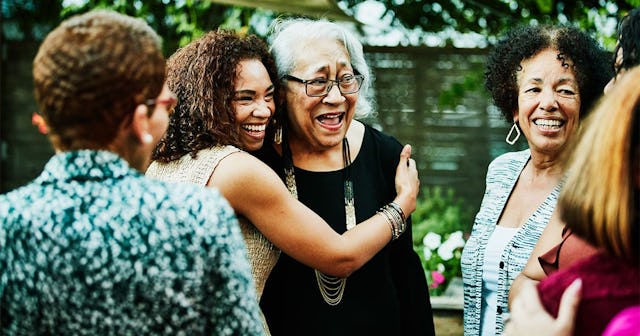Indigenous Mothers Help Raise Each Others' Kids, And It Sounds Amazing

Not all folks have the ability to benefit from a village willing and able to help raise their babies. Parenting is hard, but many hands make light(er) work, right? Or at least many hands will hopefully fold laundry, make dinner, or clean the bathroom.
I created the village of people I call family through years of friendship and the promise of casseroles and baked goods. My kids have lots of aunties. But in some cultures, specifically indigenous tribes, kids are born into families with many mothers. The role of these blood related and non-biological women is as seamless as that of the mother who gave birth. The benefits far exceed just having an extra set of hands around the house, though.
People living in the indigenous Kraho village in north-central Brazil believe children should have more than one mother, and their family dynamics stem from and perpetuate the idea that an actual village is the key to raising children. Unlike my kids who call friends of the family Auntie, Kraho children call all their mothers—their birth mom, her sister, and the women she calls sister—“inxe.” There is not a distinction between these relationships: the Kraho children know all of these women as mothers.
Renee Nader Messora, a filmmaker from Sao Paulo who became pregnant while working in the Kraho village, notes the immediate difference between the core family there and in western civilization.
Jeff Hutchen/Getty
Messora told the Washington Post, “There are between 15 to 20 people in a house. Each house has more than one mother, the children are raised by everyone, the 4-year-olds take care of the 3-year-olds who take care of the 2-year-olds. When a couple marries, the man moves into the woman’s house. All mothers stay together, there is a network of daughters, they breast-feed the children of their close relatives.”
There isn’t room for helicopter mothering in indigenous cultures. Mothers are raising their kids the same way they were raised: running freely and coming home to several women who love them.
When my then-partner and I were expecting our first child, we went to all of the classes to learn about all things pregnancy, birth, and baby. It was awkward and frustrating at times with the amount of heteronormative bias and gendered language that I experienced while being educated on how to be a first-time parent. I had to spend a lot of time educating them on inclusivity. I was identifying as female then and my ex and I weren’t shy about being in a same-sex relationship or that our child would have two moms. While mistakes were made when people consistently referred to the birth partner (me) as dad or husband, we felt welcomed in our birth classes. During a lactation class, in particular, I was welcomed in a way I was not expecting. The instructor wanted to know if I was going to induce lactation so that I could also feed our baby.
There isn’t room for helicopter mothering in indigenous cultures. Mothers are raising their kids the same way they were raised: running freely and coming home to several women who love them.
I had heard of wet nurses and knew of programs that donated breast milk to babies and parents who needed it, but the idea of me breast feeding was not appealing. I didn’t know I could force my body to do that, nor did I want to. I didn’t want to be pregnant and I certainly didn’t want to breast feed—though I wanted to be a supportive partner. The lactation consultant didn’t pressure me, but she emphasized the benefit of having more than one mother to feed, soothe, and care for the baby while the other mom could recharge in whatever way necessary.
monkeybusinessimages/Getty
The Kraho and their children benefit from the concept of many mothers in more ways than nursing. The indigenous villages’ way of raising children means women learn to share their children with other women. The defensiveness about judgment is gone because there isn’t any judgment. The parents trust the other women to keep their children safe and to teach them right from wrong with nonviolent education and correction. The kids know they have many mothers watching over them and know each woman holds the same level of authority. The village creates a hierarchy of respect and responsibility through love and community.
The defensiveness about judgment is gone because there isn’t any judgment.
Tribal villages, not just Kraho but African tribes too, also believe in a detachment to material items. All supplies and food and toys are shared. There is not a sense of territory or ownership. This feeds into their outdoor space too. Indigenous children are raised to be independent from an early age. They have the freedom to explore, experiment, and learn while getting to know their surroundings.
When they are in the Kraho village, Messora says her daughter, Mira, has a more autonomous life. “She is not always holding onto her father and I.”
There isn’t room for helicopter mothering in indigenous cultures. Mothers are raising their kids the same way they were raised: running in the forest and bathing in rivers and coming home to several women who love them.
The Kraho are adamant about delivering babies at home, surrounded by everyone the birthing mother trusts. The connection between generations is strong and sacred.
Wide open spaces, with many loving people supporting me and my children, while detaching from materialism and a fear of being replaced by someone who loves my kids?
I am respectfully here for all of this.
This article was originally published on